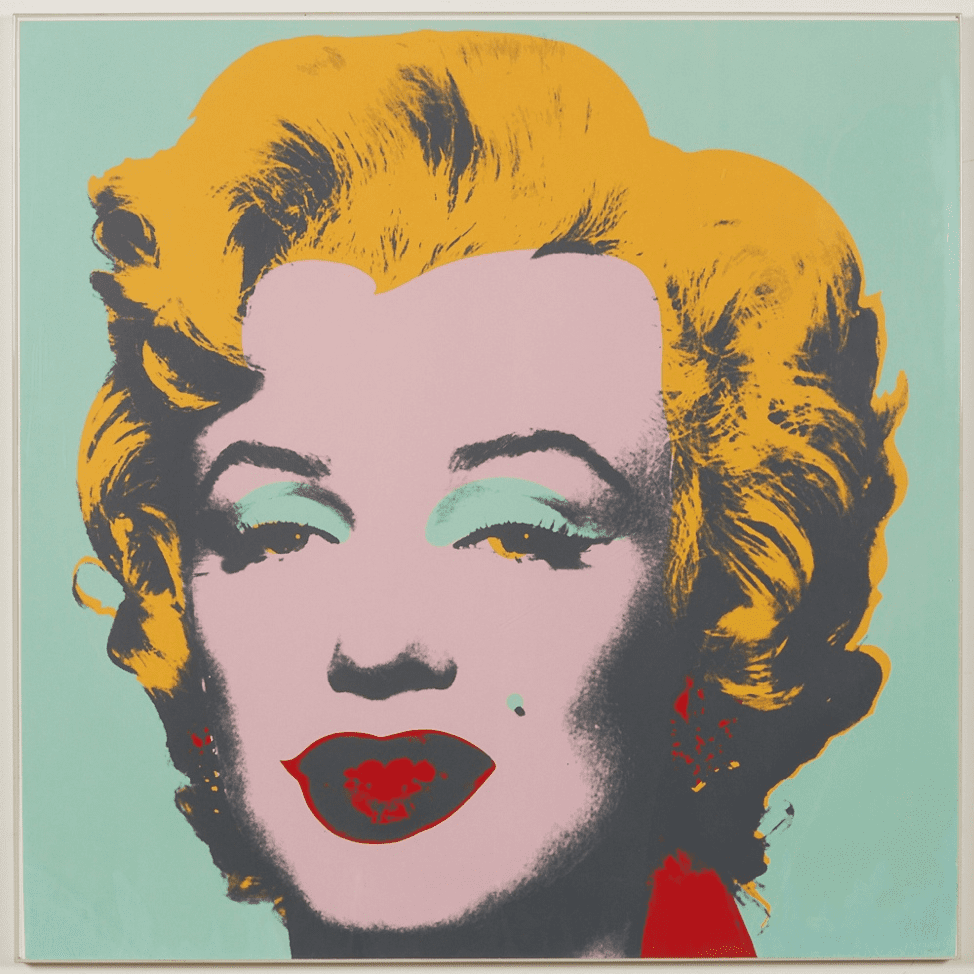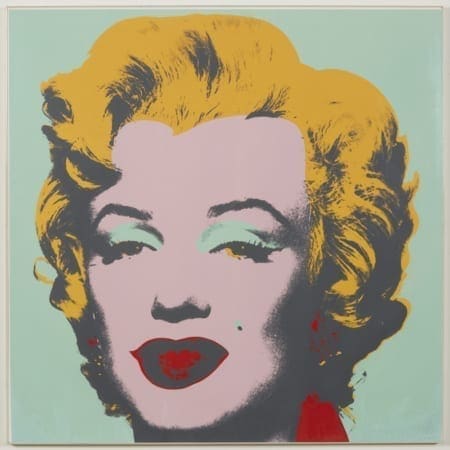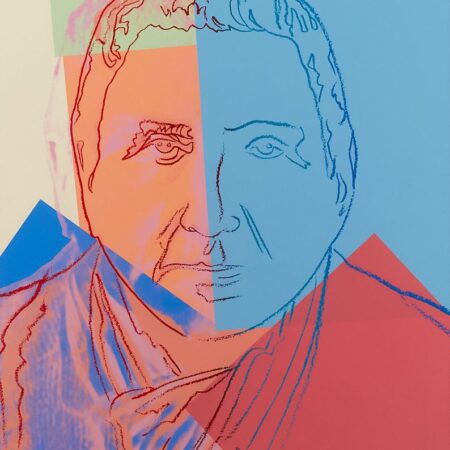
Andy Warhol
American Artist
1928-1987
Interested in selling a piece by Andy Warhol?
We have received top dollar for Andy Warhol works. Auction is the best way to quickly and transparently get maximum dollar for your artwork.

Andy Warhol Marilyn Screenprint, available in Fine and Decorative Arts on March 30, 2019, 10 AM CDT
About Andy Warhol Art
It is not an exaggeration to say that Andy Warhol’s Marilyn is one of the most recognized images of all time. Marilyn Monroe’s face extends to the edges of the frame, smirking at the viewer under heavy-lidded eyes through exaggerated, psychedelic swaths of color. Her arched eyebrows invite the viewer in. It is a face—and an interpretation of a face—that is instantly recognizable. Warhol himself was a 20th century icon, a force in the art world but also in the wider world. Warhol created art that was not only accessible to but fundamentally about the American public. An early adherent of the pop art movement, Warhol is easily its most famous figure, with his unusual talent for selecting the most ubiquitous of images and portraying them in a manner extremely fitting to pop culture: bold, exciting, and shamelessly overproduced and artificial. As art philosopher Arthur Danto explains it, Warhol was the master of capturing into art “the defining images of the American consciousness.”
Andy Warhol was born Andrew Warhola to a poor immigrant family in Pittsburgh. His early childhood was difficult, and young Warhol was frequently ill. During these periods of illness, he stayed at home from school with his mother, Julia, who he adored. To keep him occupied during bedridden periods, she and his siblings would bring him coloring books and magazines. This sparked an early interest in art, as well as a fascination with the movie stars in the magazines. Coloring, collaging, and dreaming of Hollywood got Warhol through these early illnesses, and this experience—and his choice of escape—stuck with him. After his recovery, he attended the movies weekly for the rest of his childhood, and continued this tradition with few interruptions through his adulthood.
After high school, Warhol attended the Carnegie Institute of Technology to study art. He struggled initially, since the school had a fairly traditional and academic art department, something Warhol chafed against. He struggled in his theory classes—his frequent absences from school and his immigrant parents had left him somewhat behind his peers academically—but even more than that, he longed to be creative in a way his assignments wouldn’t allow. Soon, however, things began to look up, as he gained the support of many of his professors and struck up friendships with many of his most creative classmates, many of whom, notably Philip Pearlstein, went on to become successful artists themselves.
Following graduation, Warhol moved to New York City, where he made his home for the rest of his life. He began his career working as a freelance commercial artist, something many of his artistic contemporaries were also doing, and he soon began doing well in this field. His first notable success came when the director of Glamour Magazine commissioned him to illustrate women’s shoes, something he became known for as a commercial artist. He spun this theme into his first professional success as an artist, a 1956 series of paintings of shoes. Fittingly for someone with his pop culture obsession, these shoes were named and themed after major celebrities and movie stars.
While Warhol’s career as a commercial artist had brought him financial success, his career as a fine artist took longer to take off. He did some gallery shows, which led to mixed reviews and no financial success. He began to be increasingly influenced by—and jealous of—the pioneering pop artists who moved on the edges of his circle, particularly Robert Rauschenberg and Jasper Johns, who had, by the late 1950s, managed to achieve both the success and the controversy that Warhol craved. By 1960, Warhol was making pop art in earnest. Eventually, a crisp, accurate painting of a Coca-Cola bottle—a tidy and frustrated response to the abstract expressionism he was increasingly fed up with—attracted the attention of the assistant of influential gallery owner Leo Castelli. However, getting picked up by a gallery took time. Warhol was in a constant state of production throughout the first two years of the 1960s, but had trouble striking on a subject he felt was just right. When a friend suggested he paint everyday objects that were dear to him, he began his series of money and Campbell’s soup cans, for which he had an affection due to his mother making Campbell’s soup for him in his childhood.
These series of paintings quickly attracted notice, with critics extolling the unique way he presented his objects, repeated but isolated. His career began to pick up; he showed his soup cans in Los Angeles, and was soon picked up by the Stable Gallery in New York, allowing him increased stability as a fine artist. He continued to produce series of duplicate works, and in 1962, he was introduced to silk-screening, a technique that would change the course of his career. Screen printing allowed Warhol to produce the vast quantities of identical pieces he wanted. He took a very detached view of his own—and all—art, and this new production method provided him the emotional space from his works that he desired. During this early period of his success, Warhol would work in his studio in a state of constant stimulation from the outside world, keeping a radio and a television on at all times. It is no surprise, then, that he was engrossed in the news of Marilyn Monroe’s death as soon as it occurred.
Warhol had always been fascinated with fame, but this included, and perhaps even centered on, the darker side of it. He once explained that “vacant, vacuous Hollywood was everything I ever wanted to mold my life into. Plastic, white on white.” Marilyn Monroe, at the time, was the pinnacle of this side of Hollywood. Her rise to fame from being Norma Jeane Baker had long since become the stuff of legend, and her subsequent status as the ultimate sex symbol was unrivaled. She had the most famous face in the world, a glamorous life envied by the public, and yet all of that was empty. Her highly publicized marriages had ended in divorce, and she seemed to be increasingly unhappy, struggling with substance abuse, anxiety, and depression. Warhol watched all of this unfold through the media and his regular attendance of the movies. He was intrigued by the tragic arc of her scandalous, beautiful career. Since his early childhood, he had been “preoccupied” with death, particularly when it was public, and Monroe’s death, with the context of her life, which Warhol viewed as the shell of fame hiding a deeply troubled individual, was particularly compelling to him.
The summer after Monroe’s death, Warhol began making screen prints of her. These were based on her publicity photo for Niagara, a 1953 noir film that helped solidify Monroe’s status as a star. Warhol’s fascination with her and her grisly death consumed him through the end of the summer of 1962, and he eventually made 23 series and portraits depicting Monroe. He felt screen printing was the perfect way to depict her, his bold, unfeeling lines of color reducing her captivating face into a mere “mask,” a nod to the turmoil underneath. The response to these Marilyn prints was immediate and divisive. Much of the public was enthralled, and the Museum of Modern Art purchased one of these prints; on the other hand, many critics were disgusted and shocked by his work, thinking of it as unfit for the tasteful, high-class world of art. Finally, Warhol had achieved both the recognition and the controversy he had been seeking.
The rest of Warhol’s career, despite occasional bumps, continued this upward trajectory. His bright, repetitive works were something something something. In 1964, he finally entered into the partnership with Leo Castelli he had wanted so badly in his early career. Something more about his works here. In the mid 1960s, Warhol began exploring film, and soon turned to it as his primary focus in making art, a natural move for someone as obsessed with cinema as he. Soon, he was creating stars instead of simply idolizing them. In the 1980s, he returned to painting, managing to stay cutting-edge with his works, exhibiting with up-and-comers such as Jean-Michel Basquiat. By his untimely death in 1987, he was himself a huge public figure, the kind of cultural icon he had always been obsessed with. Warhol’s constant outward focus was one of his biggest strengths. He created images everyone could relate to. He saw himself as very separate from the intellectual elites of the artistic world, choosing instead to mass-produce images of the items and people accessible to the masses. While his usage of this mass-production certainly seems to be an intellectual commentary on society—Warhol was nothing if not full of contradictions—he insisted that he was not making anything deep. In his words, “Just ordinary people like my paintings.”





